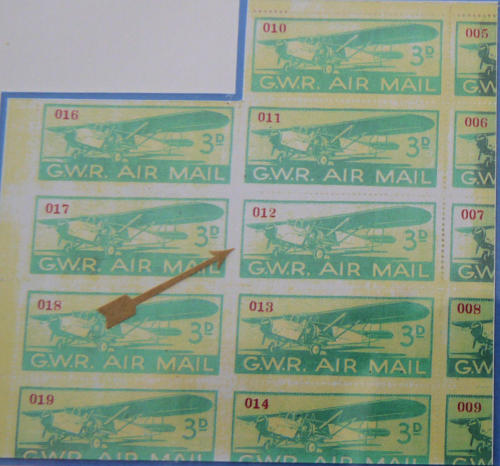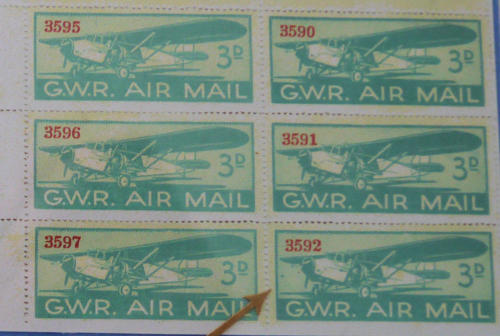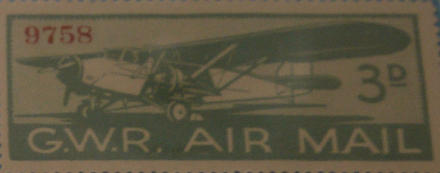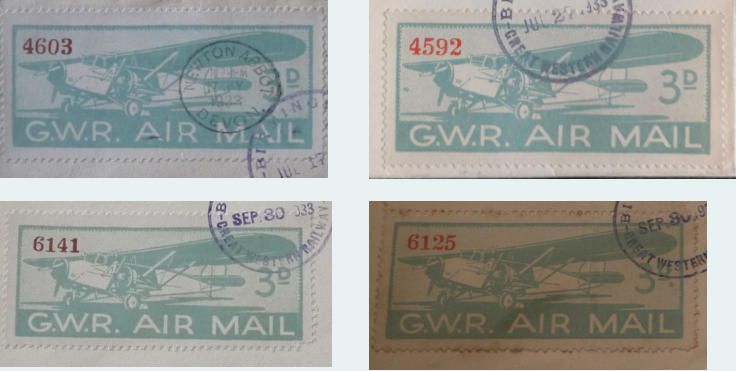
Great Western Railway - Air Label
On the 27th April GWR was authorised by the Postmaster General to carry air mail on their routes in the same manner as Railway
letters. They issued their own air label rather than using the current railway stamp and started a service on the 15th May. This
became the countries first air letter service. E.g. the letter is posted at the air destination and enters the postal system at that
point.
The GWR (Great Western Railway) 3d Air Label.
The 3d label, the first of its kind to be officially used, is of interest. The labels were printed in blocks of 20 all perforate. The first sheet 000 - 019 was not commercially used and was initially held in the archives. Most of the sheet 005 - 0019, badly stained at the top was sold to a collector That collector removed the badly stained 005 -009 and sold it. The remaining sheet 009 - 020 remains in existence as the largest surviving sheet. There was another sheet that was originally held in the archives which was a sheet numbered 000 on every stamp and overprinted ‘specimen’. This was split after going from the archives and a block of four from the sheet is shown below.
The original artist drawing prepared by G. Sawyer
which was submitted to Waterloo & Sons for the
preparation of the printing plate. Note, the out of
scale perforations which are shown round the
upper half of the design and which were adopted
into the final presentation of the label.


This block of four compared with the single examples
sometimes seen shows that the 000 labels all come from
a complete sheet numbered 000 and overstruck with
‘SPECIMEN’. The labels were printed in sheets of twenty
with 5 * 4. Thus, this example in Row 1 numbers 2 to 5.
When fully numbered they are numbered from the top
right to the bottom left. This is possibly a printer’s final
proof sheet.
This is the remaining block from the original
block kept in the GWR archives. The first
number on the labels which was flown was 20
(see next page). The numbers go from top
right to bottom left, so the two rows to the
right are missing and number 15 on the to left.
Copyright
© 2022 Robert Farquharson All Rights Reserved

The M and A joining on a sheet.
As the printing plate began to wear an error appeared in the printing. Redgrove says that the error starts from numbers 4500 onwards and is not seen after 800. The error is seen earlier than 4500 but can be mild at the beginning. The M of Mail develops a serif and in the most extreme examples it is completely joined to the A. The error only occurs on the stamps that have a 3 or a 6. The complete sheet below shows that at number 2660-2679 the errors have not started. Redgrove is of the opinion with which most experts agree that the printing was done in two stages, with the red numbers being printed later as required. This explains why the severity of the error does not follow the numbers.


An example on a flown cover from
Birmingham to Newton Abbot on the 17th
July 1933.
The Spot Variety
The second variety seen on these labels is called the spot variety. A small blue spot appears just below the middle left of row 3, column 2. It was thought that the variety appeared from the beginning of the printing, but it can be seen from an early sheet, that this is not the case.
The spot is clearly visible. The stamp above for
comparison clearly shows no spot.

Row 3,2 clearly has no spot. This from the
first printed sheet which was originally in
the GWR archives.

A larger block clearly showing the variety.

Finally, Redgrove said that he did not believe there were any
labels above 9000. Whilst this is almost certainly true for used
examples, the mint example here numbered 9758 shows that
labels in the 9000 range were printed. I believe the highest
recorded flown label number is 8970.

British Internal Airmails of the 1930’s
Dark Red Numbers
Occasionally seen are dark red instead of the normal bright red numbers. There seems to be no logic or consistency as the examples below show. There are examples in the 2000’s, 4000’s and 6000’s. If you look at the complete sheet shown above, you can see there are no dark red numbers, suggesting it is not a positional error.
Labels above 9000
Labels around the 5000 number give the most
pronounced examples. The example in 5058 is
noticeably clear.
The spot is clearly visible. The stamp above for
comparison clearly shows no spot.

Great Western Railway - Air Label
On the 27th April GWR was authorised by the Postmaster General to carry air mail on their routes in the same manner as Railway
letters. They issued their own air label rather than using the current railway stamp and started a service on the 15th May. This
became the countries first air letter service. E.g. the letter is posted at the air destination and enters the postal system at that
point.
The GWR (Great Western Railway) 3d Air Label.
The 3d label, the first of its kind to be officially used, is of interest. The labels were printed in blocks of 20 all perforate. The first sheet 000 - 019 was not commercially used and was initially held in the archives. Most of the sheet 005 - 0019, badly stained at the top was sold to a collector That collector removed the badly stained 005 -009 and sold it. The remaining sheet 009 - 020 remains in existence as the largest surviving sheet. There was another sheet that was originally held in the archives which was a sheet numbered 000 on every stamp and overprinted ‘specimen’. This was split after going from the archives and a block of four from the sheet is shown below.

This block of four compared with the single examples
sometimes seen shows that the 000 labels all come from
a complete sheet numbered 000 and overstruck with
‘SPECIMEN’. The labels were printed in sheets of twenty
with 5 * 4. Thus, this example in Row 1 numbers 2 to 5.
When fully numbered they are numbered from the top
right to the bottom left. This is possibly a printer’s final
proof sheet.
Copyright
© 2020 Robert Farquharson All Rights Reserved

The M and A joining on a sheet.
As the printing plate began to wear an error appeared in the printing. Redgrove says that the error starts from numbers 4500 onwards and is not seen after 800. The error is seen earlier than 4500 but can be mild at the beginning. The M of Mail develops a serif and in the most extreme examples it is completely joined to the A. The error only occurs on the stamps that have a 3 or a 6. The complete sheet below shows that at number 2660-2679 the errors have not started. Redgrove is of the opinion with which most experts agree that the printing was done in two stages, with the red numbers being printed later as required. This explains why the severity of the error does not follow the numbers.


The Spot Variety
The second variety seen on these labels is called the spot variety. A small blue spot appears just below the middle left of row 3, column 2. It was thought that the variety appeared from the beginning of the printing, but it can be seen from an early sheet, that this is not the case.




British Internal Airmails of the 1930’s
Dark Red Numbers
Occasionally seen are dark red instead of the normal bright red numbers. There seems to be no logic or consistency as the examples below show. There are examples in the 2000’s, 4000’s and 6000’s. If you look at the complete sheet shown above, you can see there are no dark red numbers, suggesting it is not a positional error.















































